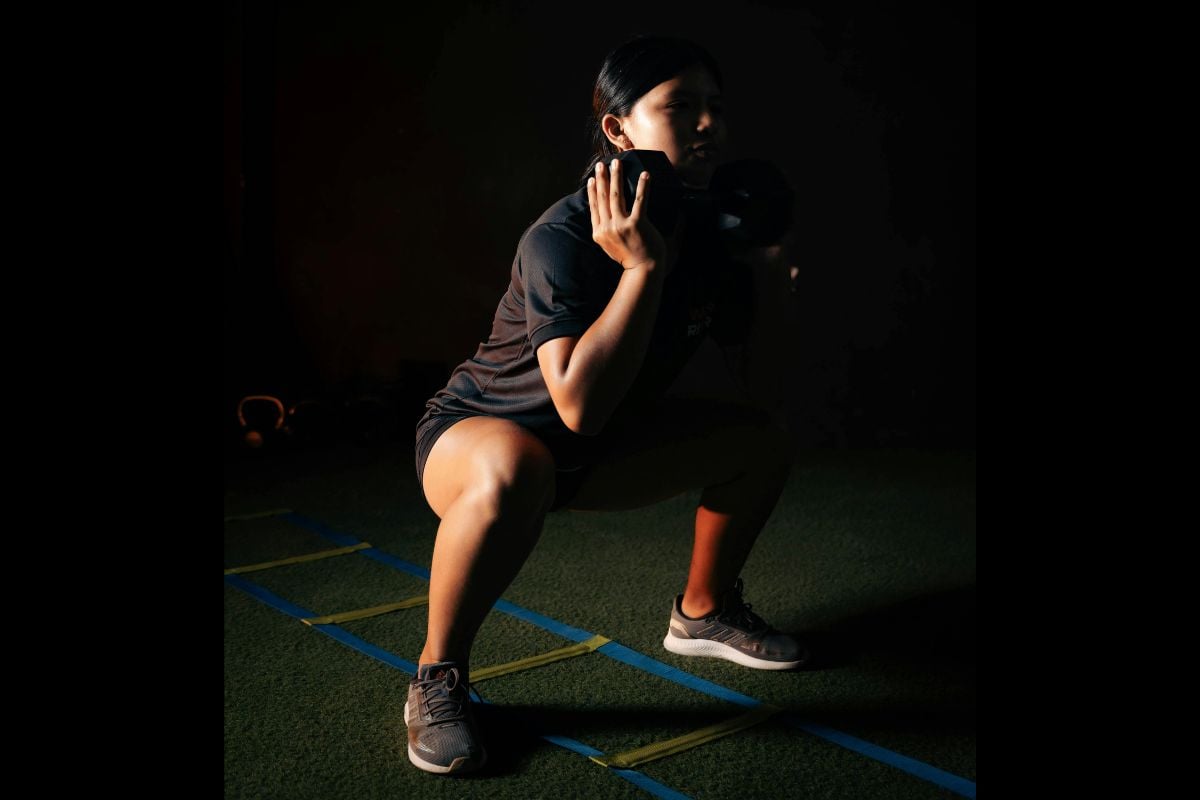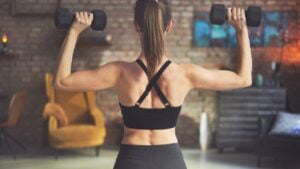If you want to build a strong and healthy lower body, you need to focus on all lower limbs, whether quads, hamstrings, glutes, calves, or adductors. But we often forget to do specific exercises for the inner thigh (adductors).
The adductors are important lower-body muscles. They maintain balance, movement, and stability and provide support during various leg exercises, such as squats, lunges, hip thrusts, and leg press.
You can do various exercises to strengthen your adductors, but this article is particularly for those who work out at home with dumbbells.
In this article, I’ll share the five inner thigh dumbbell exercises that you can incorporate into your workout routine and strengthen your thighs and legs.
Related: Dumbbell Exercises for Each Muscle
The Muscles and Functions Of the Inner Thigh

The inner thigh is made of five muscles: adductor magnus, adductor longus, gracilis, adductor brevis, and pectineus.
These muscles are responsible for moving the thigh toward or away from the body and help stabilize it during certain movements.1 Jeno SH, Launico MV, Schindler GS. Anatomy, Bony Pelvis and Lower Limb: Thigh Adductor Magnus Muscle. [Updated 2023 Oct 24]. In: StatPearls [Internet]. Treasure Island (FL): StatPearls Publishing
A little about the muscles of the inner thighs:
- The Adductor magnus is a large muscle that extends from the pubic bone down to the top of the femur.
- The Adductor longus is a smaller muscle that runs along either side of the thigh from just below your pelvic bone to just above your knee.
- Gracilis is a small muscle located just below the adductor magnus, running from your pelvis to the top of your thigh.
- The Adductor brevis attaches to either side of the gracilis, and its main function is to rotate the leg outward when you walk or run (like in walking lunges).
- The pectineus is a small muscle that attaches to the pelvis and runs down the back of the thigh. It helps to stabilize your leg when you are walking or running.
5 Best Dumbbell Exercises to Strengthen Inner Thighs
- Sumo Squat
- Curtsy Lunges
- Cossack Squat
- Frog Pumps
- Single Leg RDL to Front Lunge
These exercises are suitable for everyone, from beginners and intermediates to males and females.
Let’s find out the benefits of these exercises and how to do them with the step-by-step guide.
1. Dumbbell Sumo Squat

The dumbbell squat is one of the squat variations that work on multiple lower limbs simultaneously, including the adductors.
The stance of the sumo squat is wider than the standard squat, which is why it works more on the inner muscles of your thighs.
Research also suggests that doing squats with a larger foot stance increases thigh muscle activity, especially in the adductor longus and gluteus maximus.2 Slater, Lindsay V.; Hart, Joseph M. Muscle Activation Patterns During Different Squat Techniques, Journal of Strength and Conditioning Research: March 2017 – Volume 31 – Issue 3 – p 667-676 doi: 10.1519/JSC.0000000000001323, 3Coratella G, Tornatore G, Caccavale F, Longo S, Esposito F, Cè E. The Activation of Gluteal, Thigh, and Lower Back Muscles in Different Squat Variations Performed by Competitive Bodybuilders: Implications for Resistance Training. Int J Environ Res Public Health. 2021 Jan 18;18(2):772. doi: 10.3390/ijerph18020772. PMID: 33477561; PMCID: PMC7831128
How to perform the dumbbell sumo squat:
You can do the sumo squat in a couple of ways with the dumbbells. For example, you can hold the dumbbells on the front of your shoulders or down between your legs, depending on where you feel the good contraction in your quads.
- Grab a heavy dumbbell and stand upright with your feet 1.5 times wider than your shoulder width and toes pointing out (at a 30 to 40-degree angle).
- Hold the dumbbells between your feet or at your chest level with your elbows bent.
- Maintain an upright posture with your chest up and core tight. That’s the starting position.
- Lower into a squat as far as possible, and then pushing through your heels, return to the standing position. This will be your one rep.
Aim to perform 3-4 sets of 10-20 reps.
2. Dumbbell Curtsy Lunges
The dumbbell curtsy lunge is a great exercise for strengthening the inner thighs, biceps femoris, and glutes.4 A COMPREHENSIVE COMPARISON OF KINEMATIC, EMG, AND GROUND REACTION FORCE ACTIVITY DURING 5 DIFFERENT LUNGING TECHNIQUES – THE PENNSYLVANIA STATE UNIVERSITY SCHREYER HONORS COLLEGE. It also reinforces the core, enhances flexibility in your hips, and improves overall balance.
Steps to perform a dumbbell curtsy lunge:
- Grab one dumbbell in each hand and stand straight with your feet together.
- Putting your weight into your left foot, lift your right foot up off the floor and cross it behind your left leg and lower into a lunge position, almost as if you’re curtsying.
- Driving through your heels, return to the start. Repeat eight to 10 times and then switch to the opposite side.
- Perform an equal number of sets and reps on both sides.
Pro tips: Make sure you maintain an upright posture throughout the movement and perform each rep in a controlled manner.
3. Dumbbell Cossack Squat
The cossack squat (also known as side lunges or lateral squats) involves keeping your legs wide and squatting deep. This variation stretches and engages multiple muscles, including the adductor, and builds stability in the lower body.5 Escamilla, Rafael & MacLeod, Toran & Bonacci, Lisa & Burnham, Toni & Busch, Juliann & D’Anna, Kristen & Edwards, W. Brent & Eliopoulos, Pete & Mowbray, Ryan & Imamura, Rodney & Hreljac, Alan & Andrews, James. (2006). A Biomechanical Analysis of Squatting and Lunging Type Exercises. Medicine and science in sports and exercise. 38.
It is also a great exercise for improving balance, coordination, and flexibility in your lower body muscles, especially in your hips, knees, and ankles.6 Gao L, Lu Z, Liang M, Baker JS, Gu Y. Influence of Different Load Conditions on Lower Extremity Biomechanics during the Lunge Squat in Novice Men. Bioengineering (Basel). 2022 Jun 22;9(7):272. doi: 10.3390/bioengineering9070272. PMID: 35877323; PMCID: PMC9311947.
Steps to perform:
- Holding one dumbbell in each hand (to your shoulder level), stand straight with your feet two times wider than your shoulder-width apart and toes pointing slightly outward, 30-45 degrees.
- Bending your right knee, lower to your right side into a squat position until your left knee is entirely straight with your toe up and heel on the floor. You’ll feel the stretch in your thigh and glute.
- Pushing through your right foot into the floor, extend your knee to return to the standing position. Now repeat on the opposite side.
Aim for three sets of 8 to 10 reps on each side.
4. Dumbbell Frog Pumps
The frog pump is an excellent movement to include in your inner thigh dumbbell exercises list, as it works out your butt, hamstrings, hips, lower back, and core at the same time.
It involves lying on your back with the soles of your feet together and knees splayed outward, resembling a frog’s legs. The movement activates the adductor muscles from a different angle and helps increase solidity and flexibility in your lower body muscles.
You can alternate frog pump with other exercises to train your legs effectively, especially the gluteus maximus and adductors.
How to perform the frog pump:
- Lie on the floor, grab a dumbbell, and place it on your hip.
- Bring the soles of your feet together to splay your knees.
- Brace your core and glutes. That’s the start.
- Lift your hips off the floor while keeping them in line with your knees.
- Pause for a moment at the top and lower your hip back on the floor.
Shoot for three sets of eight to 10 reps.
5. Single Leg RDL to Front Lunge
If you’re looking to improve your overall strength, balance, and flexibility, consider performing a single-leg Romanian deadlift to front lunge. It is a challenging exercise but a great way to build up your lower body muscles, such as hamstrings, adductors, glutes, lower back, and quadriceps.
It also helps develop good posture, improves muscle coordination, solidifies the core, and reduces lower back and hamstring injuries.
So it’s best to add to your inner thigh dumbbell workout list as it targets your adductors from a different angle than other exercises.
How to do it:
- Holding a pair of dumbbells with a neutral grip, stand upright with your feet together and arms straight at your sides.
- Leaning your torso forward, lower the weight and raise your right leg behind until your chest and leg are parallel to the floor.
- Pause for a moment and then return to the start and perform a forward lunge. This will be your one rep.
- Perform an equal number of sets and reps on each side.
How Often Should You Train Your Inner Thighs?
Once a week. You can do these dumbbell inner thigh exercises interchangeably on your leg or on other muscle group days. For example, you can perform the sumo squat and curtsy lunges in your first week and the cossack squat and frog pump in your second week of workout training.
Final Words
The standard squat and lunge are great exercises for developing strong legs. However, they are not enough to target the entire lower body muscles, particularly the inner thighs (adductors).
The adductors help maintain balance, support the leg during walking, and rotate the thigh inward toward the midline of the body. They also help stabilize the pelvis when you stand and sit.
You can do various dumbbell exercises to build up your inner thighs. The inner thigh dumbbell exercises also help improve balance, flexibility, and mobility in your hips.
Strong adductors also help you perform other lower-body exercises efficiently, such as deadlifts, squats, and leg presses.
References
- 1Jeno SH, Launico MV, Schindler GS. Anatomy, Bony Pelvis and Lower Limb: Thigh Adductor Magnus Muscle. [Updated 2023 Oct 24]. In: StatPearls [Internet]. Treasure Island (FL): StatPearls Publishing
- 2Slater, Lindsay V.; Hart, Joseph M. Muscle Activation Patterns During Different Squat Techniques, Journal of Strength and Conditioning Research: March 2017 – Volume 31 – Issue 3 – p 667-676 doi: 10.1519/JSC.0000000000001323
- 3Coratella G, Tornatore G, Caccavale F, Longo S, Esposito F, Cè E. The Activation of Gluteal, Thigh, and Lower Back Muscles in Different Squat Variations Performed by Competitive Bodybuilders: Implications for Resistance Training. Int J Environ Res Public Health. 2021 Jan 18;18(2):772. doi: 10.3390/ijerph18020772. PMID: 33477561; PMCID: PMC7831128
- 4A COMPREHENSIVE COMPARISON OF KINEMATIC, EMG, AND GROUND REACTION FORCE ACTIVITY DURING 5 DIFFERENT LUNGING TECHNIQUES – THE PENNSYLVANIA STATE UNIVERSITY SCHREYER HONORS COLLEGE.
- 5Escamilla, Rafael & MacLeod, Toran & Bonacci, Lisa & Burnham, Toni & Busch, Juliann & D’Anna, Kristen & Edwards, W. Brent & Eliopoulos, Pete & Mowbray, Ryan & Imamura, Rodney & Hreljac, Alan & Andrews, James. (2006). A Biomechanical Analysis of Squatting and Lunging Type Exercises. Medicine and science in sports and exercise. 38.
- 6Gao L, Lu Z, Liang M, Baker JS, Gu Y. Influence of Different Load Conditions on Lower Extremity Biomechanics during the Lunge Squat in Novice Men. Bioengineering (Basel). 2022 Jun 22;9(7):272. doi: 10.3390/bioengineering9070272. PMID: 35877323; PMCID: PMC9311947.






